|

 Up
Up 
 Not Quite
Not Quite
Wright Kite

(You are here.)
Wind Tunnel
And Balance 
1902 Wright
Glider Model 
 Down
Down




  Need
to Need
to
find your
bearings?
Try
these
navigation aids:
If this
is your first
visit, please stop by:
Something
to share?
Please:



|
|
Available in Française, Español, Português, Deutsch, Россию,
中文,
日本, and others.
 n
the summer of 1899, Wilbur and Orville Wright designed an experiment
to test a new control system for a flying machine. When you fly you
must balance yourself in the air just as a cyclist balances himself
on a bicycle. Every little gust of wind will try to upset your
airplane just as the bumps in the road can upset a cyclist. But with
the proper control system, you can keep your airplane pointed
straight ahead and the wings level. n
the summer of 1899, Wilbur and Orville Wright designed an experiment
to test a new control system for a flying machine. When you fly you
must balance yourself in the air just as a cyclist balances himself
on a bicycle. Every little gust of wind will try to upset your
airplane just as the bumps in the road can upset a cyclist. But with
the proper control system, you can keep your airplane pointed
straight ahead and the wings level.
Will and Orv were especially concerned with that last part -
keeping the wings level. They had come to the conclusion that a
pilot must be able to roll his airplane from side to side,
something that no one had ever achieved before. To do this, they
conceived an ingenious system of cables that would twist the wings
of an airplane, angling one wingtip up and the other down
simultaneously. The wing tip that was angled up would catch the wind
on the underside and develop more lift than the wing tip that was
angled down. This, they hypothesized, would roll the airplane.
The brothers decided to test their “wing warping” system on a small,
unmanned craft before they risked their own necks on a full-size
flying machine. They built a “model glider” that could be flown as a
kite. Four control lines ran from the front corners of the model to
the ends of two sticks. By tilting the sticks in different
directions, the brothers could warp the wings and change the angles
of the wing tips. If their idea worked, the model glider would roll
back and forth as they tilted the control sticks.Wilbur finished
the model glider in late July. Orville happened to be away on a
camping trip, and Will just couldn’t wait for him to get back. On
the next windy day, he took the model out to an open field near his
home in Dayton, Ohio. Several young boys followed him to see what
was up. Will enlisted one of them to help launch his machine. The
boy help the kite over his head while Will arranged the control
lines. Then at Will’s signal, the boy released the glider and it
climbed into the air. After a few close calls, Will got the hang of
wing warping and began to roll the kite back and forth across the
sky. His hypothesis was correct, warping the wings would roll an
airplane in the sky. The control system worked!
Will was so excited that he jumped on his bicycle and rode miles
out into the countryside where Orville was camping with some
friends. Will told Orv the news and immediately the two began to lay
plans for building a full-size, man-carrying glider. In just a few
years, this wing warping system would develop into a revolutionary
system of aircraft control that would allow the Wright brothers to
unlock the secret of flight.
We've designed this kite so those of you who would like to
experience this scientific adventure for yourselves can do so with a
minimum of effort and expense. The kite performs exactly the same
way the Wrights' kite worked — you pull on the control strings to
warp the wings. However, it's not quite a Wright Kite.
First of all it's made from inexpensive materials that you can
pick up at a grocery store such as bamboo skewers, flew
straws, and trash can liners. You don't need any special skills to
make it; you just tape the parts together as we explain in
Making the Not Quite
Wright Kite.
Secondly, it's light enough that you can fly it in a light
breeze. You don't need the high winds with which Wilbur had to
contend. This makes it much simpler to learn how to fly the kite, as
we explain in Flying
the Not Quite Wright Kite.
|
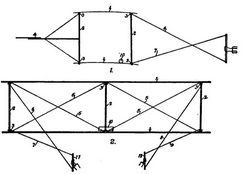
Wilbur drew this sketch in 1911 to show how his
1899 kite worked.
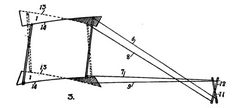
This sketch was done about the same time to illustrate how the
kite's wings twisted.
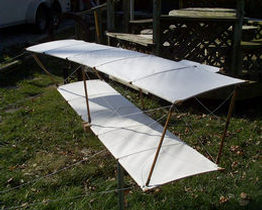
Click to see an animation of the kite as its wings are twisted by
the control strings.
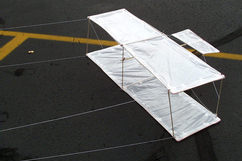
A Not Quite Wright Kite, built by one of the young people who have
participated in our workshops.
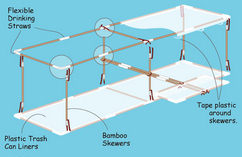
The Not Quite Wright Kite is built mostly from straws, trash can
liners, twisty-ties, and tape.
|

